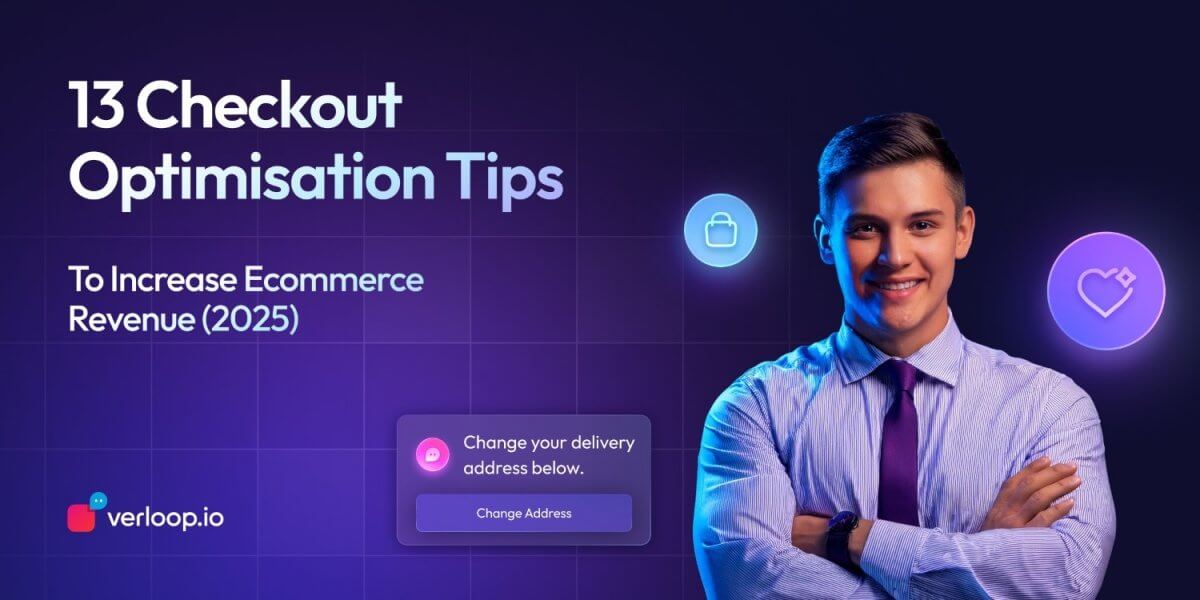13 Checkout Optimisation Tips To Increase Ecommerce Revenue (2025)
- January 22nd, 2025 / 5 Mins read
-
Harshitha Raj

13 Checkout Optimisation Tips To Increase Ecommerce Revenue (2025)
- January 22nd, 2025 / 5 Mins read
-
Harshitha Raj
In the most competitive world of e-commerce, the checkout page is the final hurdle. It’s where shoppers decide to commit or quit. A seamless checkout experience can mean the difference between a sale and an abandoned cart. As per a study, 65% of checkout results are for no sale. This is because 60% of customers leave the site within five seconds of landing on the homepage.
But there is a way that you can ensure that the customers stay on your page a little longer, which will result in lesser cart abandonment, meaning more revenue for your business.
Let’s unravel 13 tried-and-tested checkout optimisation tips that can boost your revenue in 2025.
But before we deep dive into the tips, let’s understand why checkout optimisation is so important.
Why Checkout Optimisation is Important?
As we stated before, the checkout process is the final hurdle in your customer’s purchase journey – and it’s where many stumble. Optimising this stage can significantly boost your bottom line, as statistics reveal just how high the stakes are:
- Cart abandonment rates average around 70%, meaning nearly 7 out of 10 customers leave without completing their purchase. That’s a massive opportunity cost!
- Hidden fees are deal-breakers. Unexpected costs contribute to 55% of cart abandonments. Transparency during checkout is critical.
- Slow checkout processes hurt conversions. A 1-second delay in page load time can reduce conversions by 7% and an 11% decrease in page views. This means an e-commerce store making $50000 per day would amount to $1milliion in lost sales in a year– emphasising the importance of speed.
- Mobile shoppers are on the rise. With mobile commerce expected to account for 73% of global e-commerce sales by 2025, optimising checkout for mobile users is essential for tapping into this growing market.
A poor checkout experience is like a leaky bucket – all your marketing, product development, and customer acquisition efforts risk going to waste. A smooth, efficient, and transparent checkout process doesn’t just improve conversions; it builds trust and encourages repeat purchases. After all, happy checkouts lead to happier customers and healthier revenues.
13 Tips for Checkout Optimisation
Optimising your checkout isn’t rocket science, but it does require attention to detail and customer data. Basically, you need to analyse where your customers are leaving your site more often. You can get this data by using any of the site heat map tools available. Once you have the data you need to analyse why your customers are leaving on those points, and probably use one of the following methods to optimise your checkout page.
1. Streamline Your Checkout Process
Why complicate it when simplicity sells?
Keep the checkout journey straightforward. Studies reveal that 17% of cart abandonments happen due to a lengthy process. Reduce unnecessary steps, allowing shoppers to cross the finish line faster than Usain Bolt on a good day.
Ever been asked to add your billing address separately?
Let’s not make that a thing. Instead, just add a column asking customers if their billing address is the same as their shipping address. If yes, then let them finish checkout, and if not, then only ask them to fill in the billing address.
2. Enable Guest Checkout
Commitment issues? No problem.
Forcing account creation is like asking someone to marry you on the first date. Offering a guest checkout option can reduce friction and increase conversions by up to 30%.
Instead, nudge users to create an account post-purchase when they’re basking in post-shopping bliss.
3. Use Autofill and Address Validation
Because typing is so 2020.
Save customers from a finger workout and improve checkout completion rates by integrating autofill and address validation tools. These features reduce friction and speed up the process, making the journey to the “Place Order” button seamless.
Imagine a customer is typing their address, and the form instantly suggests the correct one, including the postal code. No typos, no delays – just a smoother checkout experience.
This simple tweak can make a big difference, ensuring that the only workout your customers get is from unboxing their purchases, not typing their details repeatedly.
4. Optimise for Mobile
Picture this: A customer tries to check out on your mobile site but struggles to click a minuscule “Pay Now” button. Frustrated, they abandon their cart. Now imagine a checkout optimised with larger, easy-to-tap buttons – no frustration, just conversions.
Shoppers on the go are revenue waiting to flow. With mobile commerce projected to hit $710 billion by 2025, optimising your checkout process for mobile users is no longer optional – it’s essential.
How to optimise:
- Ensure buttons like “Confirm Payment” are large and easy to tap. Think thumb-friendly sizes, not chocolate-chip proportions.
- Minimise form fields and leverage features like mobile autofill for faster checkout.
- Test across devices to ensure a consistent, seamless experience.
By prioritising mobile checkout, you cater to the growing demographic of on-the-go shoppers and keep your revenue flowing smoothly.
5. Show All Costs Upfront
Transparency isn’t just for politicians.
Hidden fees at the final step are a surefire way to scare shoppers off. Display taxes, shipping, and any additional costs early on to maintain trust and minimise surprises. When customers know the full cost upfront, they’re more likely to proceed confidently.
Clarity builds trust. By showing a detailed cost breakdown from the start, you prevent that moment of sticker shock that sends customers running.
Instead of springing a $10 shipping fee during checkout, display it alongside the product price or allow users to calculate it early on. Transparency keeps your checkout cart rolling smoothly to the finish line.
6. Offer Multiple Payment Options
One size doesn’t fit all wallets.
From credit cards and UPI to Buy Now, Pay Later (BNPL), offering a variety of payment options ensures every customer feels accommodated. A diverse range of choices can convert hesitant shoppers into committed buyers. This is especially important as payment preferences vary by region, age group, and even purchase type.
According to a report by Statista, 11% of shoppers abandon their carts because their preferred payment method isn’t available. Flexibility is not just an option; it’s a necessity in the global marketplace.
Imagine your customer prefers GooglePay, but your store checkout page asks your customers to add a UPI link instead of a user-friendly Gpay button. That’s like offering a door but forgetting the key. By providing simple payment methods, you open the door to more conversions and happier customers.
7. Simplify Returns and Refunds
A no-hassle policy can be a hassle-free boost.
Returns and refunds are often the safety net shoppers look for when deciding to buy online. If the process is complicated or unclear, it can deter potential customers. By simplifying this step, you create confidence in your brand and encourage purchases.
How to simplify:
- Make policies visible and jargon-free on product pages and at checkout.
- Offer prepaid return labels to make the process effortless.
- Use technology to automate refund updates, keeping customers informed every step of the way.
Zappos’ “no-questions-asked” return policy is legendary, making shoppers feel secure and turning them into loyal customers. Follow suit, and your returns process can become a customer retention powerhouse.
Clearly communicate return and refund policies. 92% of shoppers will buy again if returns are easy, proving that leniency pays off.
8. Include Progress Indicators
Milestones aren’t just for road trips.
Show customers how far along they are in the checkout process with a visual progress bar. This feature not only enhances the user experience but also reduces cart abandonment rates by creating a sense of achievement as customers move closer to completing their purchase.
Why it works:
- Psychological Impact: Breaking the process into visible steps reduces the perceived effort involved. Customers feel a sense of accomplishment at every milestone, motivating them to continue.
- Clarity: Progress indicators eliminate confusion about how many steps are left, reducing frustration and boosting confidence.
Imagine you’re completing a four-step checkout process. Seeing “Step 3 of 4” with a progress bar visually reassures you that the finish line is near. Without this guidance, the process might feel endless, leading to unnecessary drop-offs.
9. Incorporate Trust Badges
Trust is earned, not given.
Reassuring customers about the safety of their transactions is essential for driving conversions. Incorporate trust badges such as SSL certifications, secure payment guarantees, and recognisable security seals prominently on your checkout page.
Trust badges can alleviate anxiety about sharing sensitive information online. Research shows that 18% of shoppers abandon their carts due to security concerns, but a visible trust badge can increase conversion rates by up to 42%, according to Blue Fountain Media.
Displaying a Norton Secure Seal or a PayPal Verified badge at checkout can give shoppers the confidence to proceed without second-guessing. It’s like a digital handshake that says, “We’ve got your back.”
10. Provide Clear Calls to Action (CTAs)
“Place Your Order” is the digital equivalent of “Seal the Deal.”
Think of “Place Your Order” as the online equivalent of “Let’s shake on it.” CTAs are your chance to guide customers with purpose and precision. Action-oriented phrases like “Shop Now,” “Get Started,” or “Claim Your Discount” give users a clear sense of direction and urgency, unlike vague alternatives such as “Submit” or “Click Here,” which feel as compelling as a lukewarm handshake.
Position these CTAs where they’re easy to spot—no one likes a game of hide-and-seek when they’re ready to take action. Use bold colours, standout buttons, and concise language to ensure they don’t get lost in the crowd. A well-placed, compelling CTA can turn hesitation into commitment.
For example, imagine you’re offering a flash sale. Instead of a generic “Learn More,” opt for something like “Snag the Deal Before It’s Gone!” It’s engaging, playful, and creates a sense of urgency—like the digital version of “Last call!”
Remember, a good CTA isn’t just a button; it’s an invitation. Done right, it’s the cherry on top of the customer journey, enticing them to click and commit. So, make it irresistible and let your CTAs do the heavy lifting.
11. Leverage Social Proof
Peer pressure, but make it positive
Peer pressure gets a digital makeover when it comes to social proof—it’s persuasion, not pressure, and it works wonders.
Imagine you’re shopping online, teetering on the edge of a decision, and then you spot a glowing five-star review or a banner that says, “12 others purchased this in the last hour.” Suddenly, the scales tip. It’s not just you considering the item; it’s a crowd of like-minded shoppers giving you a virtual thumbs-up.
Social proof taps into our natural desire to belong and make informed choices. Whether it’s customer reviews, star ratings, testimonials, or real-time purchase notifications, these little nudges act as subtle endorsements. They reassure potential buyers that your product isn’t just good—it’s popular.
For example, showcasing a testimonial like, “I was sceptical, but this product changed the game for me!” gives hesitant customers the confidence to hit “Add to Basket.” Similarly, highlighting statistics such as “Over 10,000 satisfied customers and counting” can spark trust and FOMO (fear of missing out) in equal measure.
12. Optimise Page Load Speed
Nobody likes to wait—especially online!
If your website takes its sweet time loading, potential customers might just leave for greener (and faster) pastures.
Think of your page load speed as the “first impressions” of the digital world. To ensure your site doesn’t dawdle, prioritise a few key tactics: compress large images, enable browser caching, and streamline your code. It’s the web equivalent of decluttering—lighter pages load faster. Tools like Google PageSpeed Insights or GTmetrix can help you spot the bottlenecks and fix them before your customers notice.
Your checkout process should be smoother than butter on hot toast. If a page stalls just as a customer’s about to finalise their order, it’s not just frustrating—it’s a dealbreaker. Don’t let slow speeds ruin a good sale.
13. Personalise the Experience
One-size-fits-all? Not in today’s digital landscape.
Personalisation is the secret sauce that turns casual browsers into loyal customers.
Imagine walking into a shop where the assistant greets you by name and knows exactly what you like—it feels good, right? Online, the same principle applies. Personalisation helps you cater to individual tastes and needs, creating a shopping experience that feels tailored and thoughtful.
Use customer data to recommend products based on browsing history, past purchases, or even location. For instance, a returning shopper might see, “Welcome back, Sarah! Here’s what’s new in your size.” or a first-time visitor might be greeted with, “Start your journey with 15% off your first purchase.” These little touches make a big impact.
Even email campaigns can benefit from personalisation. A subject line like, “John, your favourites are back in stock!” is far more engaging than a generic “New items available now!” It’s not just marketing—it’s making customers feel seen and valued.
When done well, personalisation transforms your brand from just another website into a trusted companion that gets your customers. It’s the difference between a mass-market approach and one that says, “We know what you’ll love.” In a world of endless choices, a personalised touch makes all the difference.
Additional Tip: Add a Chatbot to Your Checkout Flow
Instant help equals instant conversions.
Adding a chatbot to your checkout flow is like having a virtual concierge on hand to smooth out any bumps in the customer journey. Whether it’s answering last-minute questions about shipping, resolving payment hiccups, or offering personalised product suggestions, a friendly AI assistant keeps customers engaged and less likely to abandon their cart.
Imagine this scenario: a customer is torn between shipping options. A chatbot pops up, saying, “Need help deciding? Here’s a breakdown of delivery times and costs to make it easier!” Or maybe it’s a gentle nudge like, “Hey, Alex, complete your order in the next 10 minutes to enjoy an extra 10% off as a loyalty perk!” These small, conversational touches can make a big difference.
Businesses using chatbots see an average 10% increase in checkout completion rates. But the magic doesn’t stop there. When paired with AI capabilities, chatbots can offer tailored discounts, suggest alternative payment methods, or even upsell complementary items—all in real time.
This is where Verloop.io steps in as a game-changer. With its conversational AI platform, Verloop.io integrates seamlessly into your e-commerce checkout process, offering intuitive and multilingual support (including Arabic). It helps customers with everything from product queries to payment troubleshooting, ensuring a smooth and satisfying checkout experience. Plus, Verloop.io’s ability to personalise interactions based on user behaviour can significantly boost your conversions.
Adding a chatbot isn’t just about convenience—it’s about creating a checkout process so smooth, that your customers will wonder how they ever shopped without it. With tools like Verloop.io, you’re not just optimising your flow; you’re redefining it.






